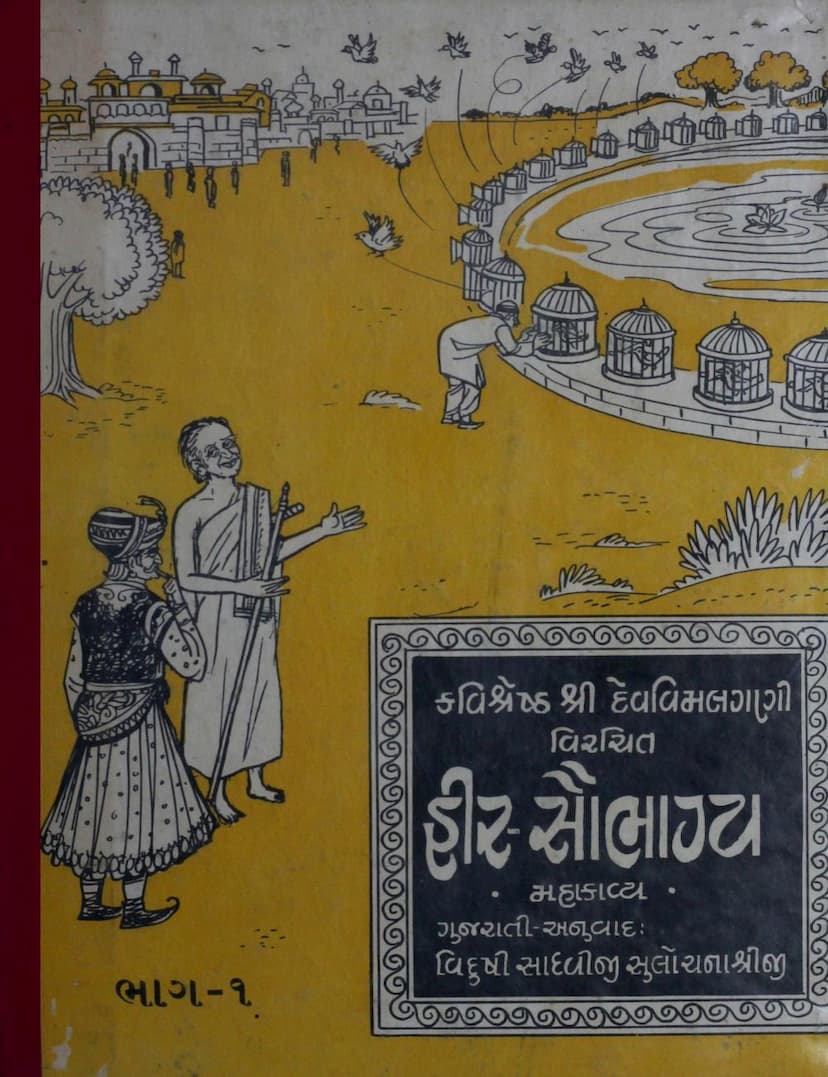Heersaubhagya Mahakavyam Part 01
Added to library: September 1, 2025

Summary
Heersaubhagya Mahakavyam Part 01: A Comprehensive Summary
This comprehensive summary covers the content of the first part of the Heersaubhagya Mahakavyam, a significant Jain epic poem authored by Devvimal Gani and translated by Sulochanashreeji. The publisher is Kantilal Chimanlal Shah. The catalog link provides access to the text.
Overall Context: The Heersaubhagya Mahakavyam is a grand epic poem that narrates the life story and spiritual journey of Acharya Vijay Heer Suri, a prominent Jain monk and scholar. This first part, comprising eight chapters (sargas), sets the stage for the epic by describing the celestial and earthly realms, the lineage leading to Acharya Vijay Heer Suri, and the auspicious birth of the protagonist.
Key Themes and Content:
-
Praise and Invocation (Mangalācharaṇa):
- The text begins with invocations to Lord Parshvanatha and other revered figures, seeking their blessings for the successful completion of the epic.
- There is an acknowledgment of the author's humility in undertaking such a grand task and a recognition of the divine grace required.
-
The Jain Cosmology and Geography:
- The poem delves into the Jain cosmology, describing Jambudvipa, the central continent of the universe in Jainism.
- It meticulously describes Bharat Kshetra, the earthly realm where much of the narrative unfolds. This includes descriptions of cities, rivers, mountains, and the general prosperity and beauty of the land.
- Specific geographical locations like Gujarat, Anandpur (Vadnagar), Taranga-ji, and Shankheshwar are mentioned as important Jain pilgrimage sites, highlighting their sanctity and historical significance.
- The text also paints a picture of the cultural and social milieu of Gujarat during the period, noting the governance of rulers like Akbar and the general peace and prosperity.
-
Genealogy and Lineage:
- The narrative traces the lineage of Acharya Vijay Heer Suri, mentioning his parents, Seth Kushal Shah and Nathiben, and their exemplary lives.
- The text highlights the auspicious signs and events surrounding the birth of Heer Suri, emphasizing his divine destiny and spiritual potential.
-
The Author and Translator:
- Devvimal Gani, the original author, is presented as a learned scholar who composed this epic.
- Sulochanashreeji is recognized as the translator into Gujarati, lauded for her profound knowledge and ability to convey the spiritual essence of the original Sanskrit text. Her dedication to making this complex work accessible to a wider audience is evident.
-
The Publisher and Supporters:
- Kantilal Chimanlal Shah is acknowledged as the publisher, indicating a collaborative effort in bringing this work to light.
- The publication was supported by various individuals and the Navrangpura Jain Sangh, underscoring the community's commitment to disseminating Jain knowledge.
-
Literary and Philosophical Depth:
- The poem is rich in literary devices, including elaborate metaphors, similes, and personification, particularly in the descriptions of nature and auspicious events.
- The prose is described as beautiful and flowing, enhancing the aesthetic appeal of the narrative.
- There's an underlying philosophical current that emphasizes righteous conduct, spiritual discipline, and the pursuit of liberation (moksha), core tenets of Jainism. The importance of knowledge (
Jnana) and devotion (Bhakti) is also subtly woven into the narrative.
-
Detailed Descriptions:
- The text provides vivid descriptions of natural beauty, including seasons, flora, and fauna, often using them as allegories or to enhance the spiritual atmosphere.
- The descriptions of cities, palaces, and the protagonist's physical form are ornate and detailed, characteristic of classical Indian Mahakavyas.
-
Dedication:
- The book is dedicated to the memory of the late Acharya Devesh Vijay Siddhisuriji Maharaj, acknowledging his profound influence and guidance on Sulochanashreeji.
Summary of the Sargas (Chapters) based on the provided index:
- Prathamaha Sargaḥ (First Chapter): Covers auspicious beginnings (
Mangalacharaṇam), the subject matter (Abhidheyārth pratipādan), the author's humility (Kaver-a nauddhatya prakashak), descriptions of Jambūdvipa and Bharat Kshetra, and mentions of various pilgrimage sites and their significance. It also describes seasonal changes (Rutuvarnan) and the city of Prālādhanpur (Pālanpur). - Dwitiyaha Sargaḥ (Second Chapter): Focuses on the lineage of the protagonist, including descriptions of his parents (
Kangsaha Varnanam,Nathī Varnanam), the divine conception and auspicious signs (Garbhādhāna Varnanam,Hohada Varnanam), the birth ceremony (Prasava samay Varnanam,Janma samay Varnanam), and the auspicious infancy of the hero Kumar (Hīra kumāra sarvāṅga varnan,Kumāra guṇalakṣaṇādivarṇan,Hīra kumāra krīḍānivāsādivarṇan). - Tṛtīyaha Sargaḥ (Third Chapter): Continues the narrative of the hero's early life, including detailed descriptions of his physical attributes and the auspicious atmosphere surrounding him.
- Chaturthaḥ Sargaḥ (Fourth Chapter): This chapter likely shifts focus to other significant figures or historical accounts within the Jain tradition, mentioning various Tirthankaras and important Jain Acharyas like Bhadrabāhu Swami, Sthulabhadra, and others. It also likely covers the spiritual lineage and teachings leading up to the current era.
- Pañchamaḥ Sargaḥ (Fifth Chapter): This part of the summary details the protagonist's upbringing, his early education, his interactions with his family, and particularly his profound understanding of spiritual principles. It highlights his contemplative nature and his developing detachment from worldly pleasures. The descriptions of his interactions with his sister Vimla, and his eventual renunciation are key elements.
- Ṣaṣṭaha Sargaḥ (Sixth Chapter): This chapter likely continues with the hero's journey, possibly detailing his decision to renounce the world, his spiritual training, and significant events that further shaped his path towards enlightenment. The descriptions of places, gatherings, and philosophical discussions would be prominent here.
Conclusion: The first part of Heersaubhagya Mahakavyam is a meticulously crafted work that not only narrates the life of Acharya Vijay Heer Suri but also serves as a repository of Jain cosmology, history, and cultural traditions. The translation by Sulochanashreeji aims to make this profound spiritual epic accessible, enriching the understanding of Jainism for Gujarati readers. The sheer detail and devotion poured into the composition and translation speak volumes about the reverence for the subject matter.